1863 Wade and Ford
Civil War Surgical Set
Owned by: Josiah Howell Culver, M.D., U.S.
Army, U.S. Navy
Documented set owned by a Civil War Federal
Army and Naval
Asst. Surgeon
William Ford and George
Wade joined forces to start an instrument business during 1861 as 'Wade and
Ford;. The business was located in New York at 85 Fulton from 1860 -
1866. They worked with Dr. James R. Wood, a surgeon, on the design of
this type of surgical set.
This surgery set is a civilian, not military production. It was sold during the Civil War to a Civil War Navy Surgeon.
Extensive discussion of Civil War era surgical sets by Wade and Ford and others:
Additional discussion of
Civil War surgical set identification and sets by Wade & Ford and Ford & Gilman as well as which military surgical sets the major and minor makers may have supplied.
Also see: How to Identify Civil
War era sets. There are several resources on this site to help you identify the earliest sets used during the Civil War via the 1861
Army Supply Table.
The William F. Ford time frame and location information is from Edmonson's:
American Surgical
Instruments: an illustrated history:
Source: American Surgical Instruments: American Surgical Instruments: An Illustrated History of their
Manufacture and a Directory of Instrument Makers to 1900 by James M. Edmonson, Ph.D., Curator, Dittrick Museum of Medical
History, Cleveland Medical Library Association and Case Western Reserve
University.
Wade
& Ford (George Wade and William E Ford) 1860-66: 85 Fulton
Their Civil War period instruments are marked: 'Wade & Ford / New. York'
Following the Civil War, the partnership of Wade and Ford was dissolved. In March 1866 Wade sold his share of the business to William F. Ford. Ford operated the business at the 85 Fulton Street address until 1870. Ford then sold the business to Shepard and Dudley in 1870, who began business at 150 William Street." (Edmonson, page 82). This information is backed up by medical
society and other business documents in New York during the 1870's, which you can easily access on Google books under Ford, Shepard, Dudley.
Edmonson notes that
'following the Civil War, Wade & Ford ceased to exist in 1866, see page 82
|
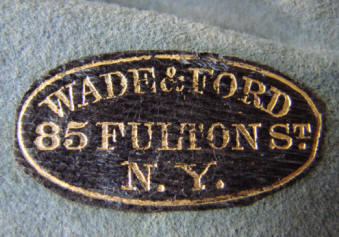
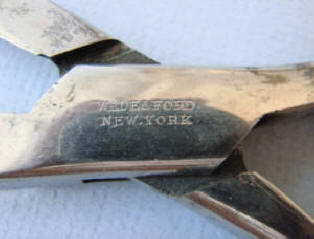
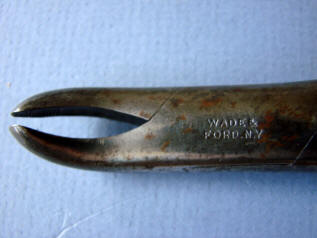
|
|
Trade label and marked surgical instruments for 'Wade & Ford'
|
Edmonson further tracks W.F. Ford's history,
see two pages of Ford location details on page 218:
'William F. Ford & Co.' (William F. Ford and George Gilman) association
1866-71: at 85 Fulton, N.Y.
William F. Ford associated with Shepard & Dudley in 1870.
|
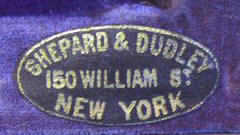
|

|
|
Trade & Billhead for Shepard & Dudley / W.F. Ford 1877 |
W. F. Ford was also associated with Caswell-Hazard & Co. at some point in the 1870 -1880s and as a manager of that company until 1891. Some of his instruments are marked W.F. Ford, NY during this period.
|
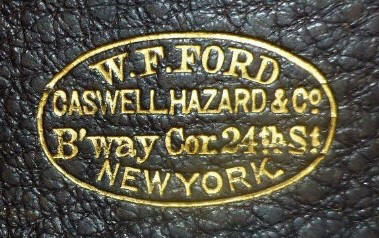
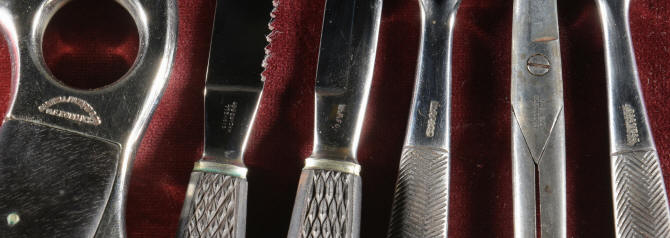 |
|
Marked instruments stamped 'Caswell Hazard & Co., W.F. Ford NY or Caswell Hazard & Co. Ford'
|
Edmonson notes that 'W. F. Ford' eventually went out on his own in 1875 - 1890.
Ford was then located at 1099 Broadway, N.Y until 1890, then opened W. F. Ford Surgical Instruments at 315 Fifth Ave., N.Y from 1891 - 1900. During this period, instruments will be marked 'W.F. Ford, NY'
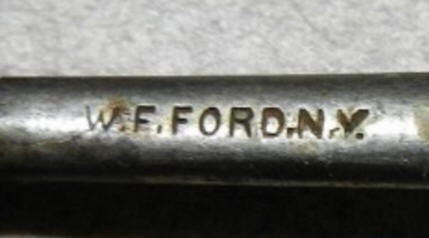 |
|
Instrument marked 'W. F. Ford, N.Y.
|
Conclusion regarding W.F. Ford, N.Y. marked instruments:
'W.F. Ford, N.Y. ' would have rarely been marked on any instrument with just his name and not the company's name until the 1870s at the earliest and he never made surgical sets during the Civil War with only his name on the instruments or makers label. He was NOT in business by himself during Civil War or marking instruments with only his name until c.1870s.
|
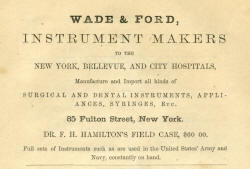

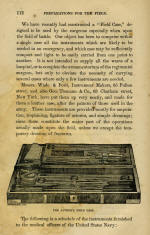
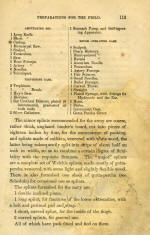
|
|
Above is an entry in Hamilton's
book on surgery showing he devised set specifications
for the U. S. Navy (Click to enlarge) Notice the information
immediately below the drawing of a surgery set, which is most
likely from an earlier period noting the banding style and keyed
lock, which would not be military issue)
Also see Federal Navy surgical set owned by Lewis Whiting,
M. D. |
On display is a Civil War-date
general operating set as designed by James R. Wood, M.D. (1813-1882), in
conjunction with the firm Wade & Ford (1860-1866), New York. For a
discussion of this collaboration, see Edmonson, pp. 80-81. Also
see the diagram of
this type set as illustrated in the Civil
War Hand-book of Surgical Operations, 279 pages, 1862, by Stephen Smith
(1823-1922)
The brass cartouche on the lid is
engraved: J. H. Culver / 1863. Josiah Howell Culver, M.D.
(1837-1868), an 1863 graduate of the Medical University of the
City of New York:
Josiah Howell Culver was born at
Moriches Suffolk County New York September 10th 1837 and after a suitable
preliminary education commenced his medical studies in his native place
graduating at the New York University Medical College in 1860 Having
abandoned what he intended to be his establishment at East Hampton Long
Island for the military service he was appointed in September 1862 an Acting
Assistant Surgeon United States Army and assigned to the David's Island
Hospital New York Harbor. Here he remained until March 1863 when he entered
the United States Navy his brilliant examination having secured him the
first rank in a class of twelve. From his first station at the Naval Hospital
Brooklyn he was ordered to Charleston on board the Philadelphia, the flag
ship of the South Atlantic blockading squadron. While on the line of duty he
suffered from severe debilitating pulmonary hemorrhages from the
consequences of which he never fully recovered although his health was
apparently benefited by sick leaves and short residences in Minnesota and
Florida. Much to his regret he was placed on the retired list in July 1867
and slowly declining after much suffering he breathed his last on
September 25th 1868 (Transactions of
the American Medical Association. Vol. XXI, 1870, pg 497-8.)
See
Culvers' actual written exam for admission to the U. S. Navy in 1863
Evolution of
the University of the City of New York, Department of Medicine
1841 -
University Medical College organized as the Medical
Department of the University of the City of New York
1861 -
Bellevue Hospital Medical College Founded
See the
commencement notice for Culver at New York
University in 1863, address by none other than Dr.
Valentine Mott.
From the December 1879,
second edition, Alumni Association, Page 91:
|
Josia
Howell Culver, Melville, Long Island, N.Y.
Graduated, Bellevue, 1860
A. A. Surg.
U.S.A., 1862 -1863.
Asst. Surg. U.S.N. March
1863.
Placed on retired list on account of ill
health, July, 1867.
Died Sept. 25, 1868."
|
Josiah H. Culver was commissioned a United States Navy assistant surgeon
in March of 1863, which means he was trained at the Bellevue Hospital Medical
College and New York University, and then served in the Navy beyond the Civil War until 1867 when he
was retired.
Dr. Culver served on the Federal Navy steamer 'Philadelphia' as an assistant
surgeon.
Dr. Culver may have received the set at the time of his commission in
1863. The source for this documentation is the List of Officers of the Navy of the
United States and the Marine Corp from 1775 to 1900.
Assistant Surgeon
Josiah H. Culver served on Federal Navy Steamer
'Pawnee', Additional information on the
'Pawnee' during the Civil War. He also served on the Civil War Federal Navy South Atlantic Blockading Squadron:
Steamer 'Philadelphia', 1865
Additional information on the
'Philadelphia" during
the Civil War.
Acting Master, George H. Avery.
Acting Ensigns, George R. Bailey, George Edwards, E. R. Davison, John B.
Starr, and Charles D. Duncan.
Assistant Surgeon, Josiah H. Culver.
Assistant Paymaster, Horatio L. Wait.
Engineers: Acting First Assistant, Robert Mulready; Acting Third
Assistants, Chas. T. Wamaling, and John Ryan.
NAVY GAZETTE REGULAR NAVAL SERVICE
ORDERED: March 14 Assistant
Surgeon J. H. Culver to the
Princeton
The United
States army and navy journal and gazette of the regular ..., Volume 3
May 19, 1866 DETACHED:
Assistant
Surgeon Josiah H Culver from
the Princeton
and placed on sick leave.
A notice in the New York Times, July
23,1867 shows
Assistant Surgeon Josiah H. Culver has been placed on the retired list
in the Navy Gazette.
Dr. Josiah Culver and Mary Conkling Culver
(he was a US Navy doctor) lived in Wainscott, N.Y.

Click on any
photo to enlarge

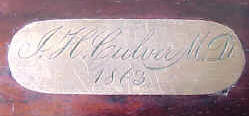
Note the lock is civilian 'keyed' and the engraving is to the owner, not the Army or Navy
d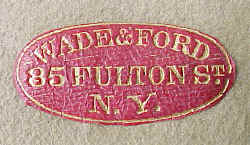
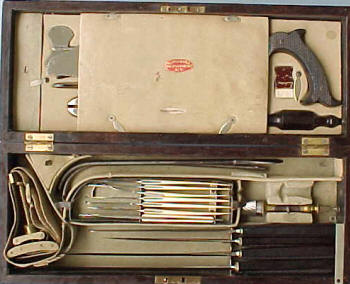
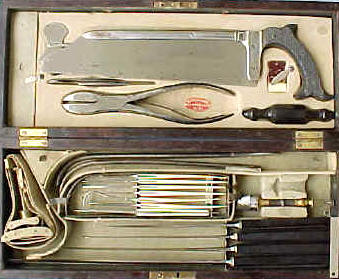
Set open with divider (left) in place and
removed (right)


Drawing from Smith's Civil War Surgery
manual
and a lecture ticket for James R. Wood, MD at Bellevue, 1864-65, who
recommended the lay-out of this set
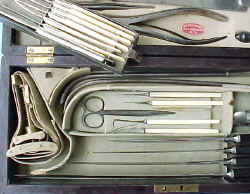
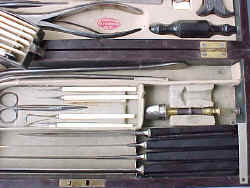
Center tray removed to show eye-surgery
instruments below

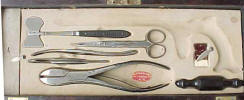
Capital saw removed to show neuro-surgery
instruments below
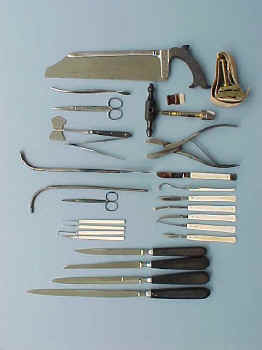
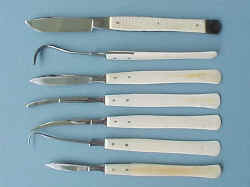
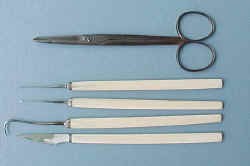
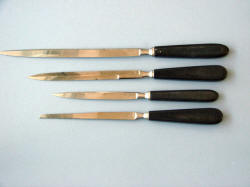
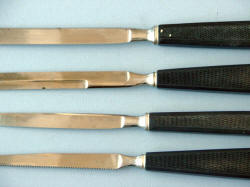
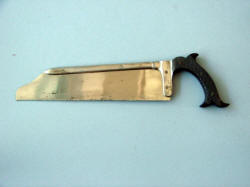
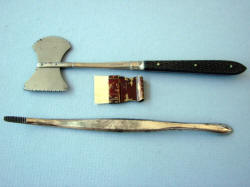
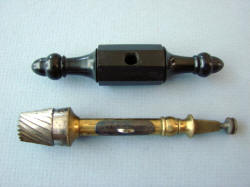
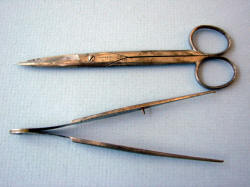
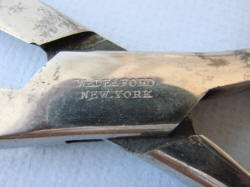
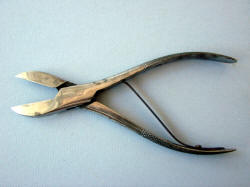
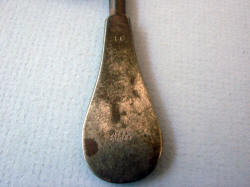
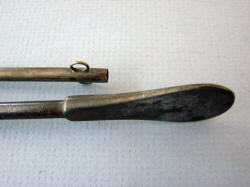
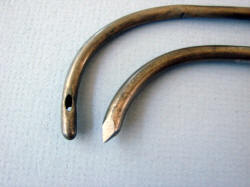
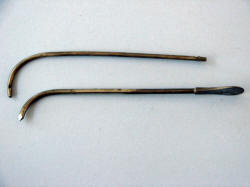
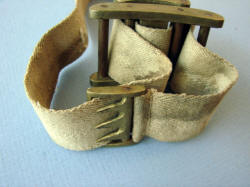
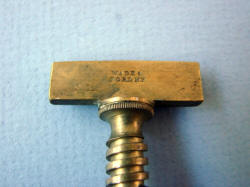
Note the small cast brass prong frame and
hinged brass prongs
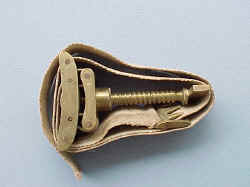
Display 1 |
Display 2 |
Display 3
Display 4 |
Display 5 |
Display 6
|

























